
As the founder of The Provincial Freeman newspaper, Mary Ann Shadd (1823-93) was the first Black woman to edit and publish a newspaper in North America. The American-born educator and abolitionist moved to Windsor, Canada West (now Ontario), where she established a racially integrated school in 1851, followed by The Provincial Freeman in 1853. We asked Adrienne Shadd, a historian, and her daughter, Marishana Mabusela, both the great-great-great and great-great-great-great-nieces, respectively, of Mary Ann Shadd, about their connection to their famous ancestor. Their answers emphasized how the growing impetus to tell the stories of Black Canadians, particularly Black women whose lives were doubly concealed, can make a difference in a single generation.
“My generation wasn’t told about the Shadd past and the legacy of our family’s accomplishments.”
“I didn’t learn about Mary Ann Shadd until about 1973 or 1974, when I went to what is now the Buxton National Historic Site & Museum,” explains Adrienne Shadd. “Arlie Robbins, who worked at the museum at the time, casually handed me an article entitled ‘Mary Ann Shadd: Negro Editor, Educator, and Lawyer’. I asked, ‘Who is Mary Ann Shadd?’ When I read the article and learned about this woman and all her accomplishments, I was astounded. She had been a teacher, a newspaper publisher and editor, a lawyer, an abolitionist, and a public speaker when it could be dangerous for a woman to do so. Not only that, but she was also a member of my own family!”
Thanks to her mother’s efforts researching their past, Marishana Mabusela learned about their family history from an early age. “My first memories are seeing her face on several of my mom’s books,” remembers Mabusela. “I must have asked, ‘Who is that?’ or ‘Why are you always reading that book?’ She probably explained multiple times, on different occasions, who she was, what she did, why she was important and how we were related to her. It took years for all her accomplishments to truly sink in. To be honest, I am still learning about them.”
Knowledge is life changing
Adrienne Shadd adds that since she had “learned” as a young person that “Black people had made no contributions whatsoever to civilization,” discovering the story of her great-aunt was pivotal. “I think the trajectory of my life changed in that moment. I was so inspired and exhilarated by the story of Mary Ann Shadd’s life and work, and that of her family, that I wanted to know more about Black people’s achievements in general, because I did not learn about these things as a young person growing up. I knew in that moment that there was a lot of important history that was waiting to be discovered. And why shouldn’t I be one of those to uncover this history?”
“Knowing my history has instilled immense confidence in myself and my abilities.”
Adrienne Shadd’s research and love for her history laid the groundwork for building a sense of pride in a heritage that would influence her daughter’s future. “I come from a strong community. Knowing my history has instilled immense confidence in myself and my abilities. It is the wider legacy of the Shadd family and the Elgin Settlement* that does that for me,” says Mabusela. “Mary Ann Shadd was one among many accomplished ancestors and family members. Seeing her receive such public recognition given what she went through at a time when women – particularly Black women – were not respected, gives me confidence to accomplish my dreams despite the obstacles.”
“The Provincial Freeman is a treasure trove of information.”
“As a historian, I am extremely grateful that The Provincial Freeman existed,” says Adrienne Shadd. “It is a treasure trove of information on the Black community in Canada West. It has been invaluable in telling us who many of the leaders of the communities were, what their organizations and activities were, what the clashes among different factions of the community were, and what impact the events in the province were having in the U.S. and other parts of the world. People were looking at Canada West to see how these free Blacks were faring and to see if they could excel living in freedom in Canada. It was a great source of pride for the Black community.”
A philatelic first
In 2009, Abraham Doras Shadd, Mary Ann’s father, was featured on one of Canada Post’s first Black History Month stamps. Except for King George VI and Queen Elizabeth II, this is perhaps the only time both a father and daughter have appeared on Canadian stamps. “It is an honour to be part of a family that has been recognized in this way,” notes Adrienne Shadd. With an eye to the future, Mabusela adds, “Perhaps they will not be the last!”
Canada Post issues Black History Month stamps to reveal the stories of courage, accomplishments, and contributions of Black Canadians. Hopefully, through these efforts – and those of others – future generations will benefit from the sense of pride and awareness that comes from better understanding the lives and challenges of those who came before.
* Also known as Buxton, the Elgin Settlement was the largest and considered the most successful early Black community in Canada West, located in what is now the Municipality of Chatham-Kent. Established in 1849 by Reverend William King, the Elgin Settlement was one of the last stops on the Underground Railroad.

2024 Black History Month stamp celebrates the legacy of Mary Ann Shadd
Available now